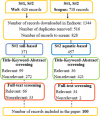A review of the toxicological effects and allergenic potential of emerging alternative protein sources
- PMID: 39865634
- PMCID: PMC11771606
- DOI: 10.1111/1541-4337.70123
A review of the toxicological effects and allergenic potential of emerging alternative protein sources
Abstract
The growing environmental pressure of the animal food chain requires a system shift toward more sustainable diets based on alternative protein sources. Emerging alternative protein sources, such as faba bean, mung bean, lentil, black gram, cowpea, quinoa, hemp, leaf proteins, microalgae, and duckweeds, are being explored for their potential in meeting global protein demand and were, therefore, the subject of this review. This systematic literature review aims to understand the current knowledge on the toxicological effects and allergenic potential associated with these sources and derived protein and food products. The findings identified potential concerns associated with the presence of plant secondary metabolites, including antinutritional factors, phytoestrogens, and oligosaccharides, in all the sources included. Also, these protein sources have been shown to display allergenic properties, either through the intrinsic presence of allergens or through cross-reaction. Further, the effects of food processing on these proteins remain poorly understood and no conclusive data are available to quantitatively assess their safety after processing. Overall, those findings highlight the need for quantitative knowledge of the food safety attributes related to final food products. This will enable a concrete and preventive approach to food safety in the protein transition.
Keywords: allergenicity; alternative protein sources; antinutritional factors; food safety; microalgae.
© 2025 The Author(s). Comprehensive Reviews in Food Science and Food Safety published by Wiley Periodicals LLC on behalf of Institute of Food Technologists.
Conflict of interest statement
The authors declare no conflicts of interest.
Figures
Similar articles
-
Systemic pharmacological treatments for chronic plaque psoriasis: a network meta-analysis.Cochrane Database Syst Rev. 2017 Dec 22;12(12):CD011535. doi: 10.1002/14651858.CD011535.pub2. Cochrane Database Syst Rev. 2017. Update in: Cochrane Database Syst Rev. 2020 Jan 9;1:CD011535. doi: 10.1002/14651858.CD011535.pub3. PMID: 29271481 Free PMC article. Updated.
-
Systemic pharmacological treatments for chronic plaque psoriasis: a network meta-analysis.Cochrane Database Syst Rev. 2020 Jan 9;1(1):CD011535. doi: 10.1002/14651858.CD011535.pub3. Cochrane Database Syst Rev. 2020. Update in: Cochrane Database Syst Rev. 2021 Apr 19;4:CD011535. doi: 10.1002/14651858.CD011535.pub4. PMID: 31917873 Free PMC article. Updated.
-
Systemic pharmacological treatments for chronic plaque psoriasis: a network meta-analysis.Cochrane Database Syst Rev. 2021 Apr 19;4(4):CD011535. doi: 10.1002/14651858.CD011535.pub4. Cochrane Database Syst Rev. 2021. Update in: Cochrane Database Syst Rev. 2022 May 23;5:CD011535. doi: 10.1002/14651858.CD011535.pub5. PMID: 33871055 Free PMC article. Updated.
-
A systematic review and economic evaluation of epoetin alpha, epoetin beta and darbepoetin alpha in anaemia associated with cancer, especially that attributable to cancer treatment.Health Technol Assess. 2007 Apr;11(13):1-202, iii-iv. doi: 10.3310/hta11130. Health Technol Assess. 2007. PMID: 17408534
-
The risks, benefits, and resource implications of different diets in gastrostomy-fed children: The YourTube mixed method study.Health Technol Assess. 2025 Jul;29(25):1-21. doi: 10.3310/RRREF7741. Health Technol Assess. 2025. PMID: 40620081 Free PMC article.
References
-
- Abd El‐Hady, E. A. , & Habiba, R. A. (2003). Efffect of soaking and extrusion conditions on antinutrients and protein digestibility of legume seeds. Lebensmittel‐Wissenschaft Und‐Technologie‐Food Science and Technology, 36(3), 285–293. 10.1016/s0023-6438(02)00217-7 - DOI
-
- Abril, R. , Garrett, J. , Zeller, S. G. , Sander, W. J. , & Mast, R. W. (2003). Safety assessment of DHA‐rich microalgae from Schizochytrium sp. Part V: Target animal safety/toxicity study in growing swine. Regulatory Toxicology and Pharmacology, 37(1), 73–82. 10.1016/S0273-2300(02)00030-2 - DOI - PubMed
-
- Adedapo, A. A. , Mogbojuri, O. M. , & Emikpe, B. O. (2009). Safety evaluations of the aqueous extract of the leaves of Moringa oleifera in rats. Journal of Medicinal Plants Research, 3(8), 586–591. https://www.scopus.com/inward/record.uri?eid=2‐s2.0‐73449095737&partnerI...
-
- Affrifah, N. S. , Phillips, R. D. , & Saalia, F. K. (2021). Cowpeas: Nutritional profile, processing methods and products—A review. Legume Science, 4(3). 10.1002/leg3.131 - DOI
-
- Agrawal, S. , Panigrahi, C. , & Eri, R. (2024). An elaborative discussion on the potentiality, functional characteristics, curative effects, antinutritional factors, processing, and industrial applications of faba beans (Vicia faba L.) as a versatile legume. International Journal of Food Science and Technology, 59(1), 30–57. 10.1111/ijfs.16803 - DOI
Publication types
MeSH terms
Substances
Grants and funding
LinkOut - more resources
Full Text Sources
Medical



